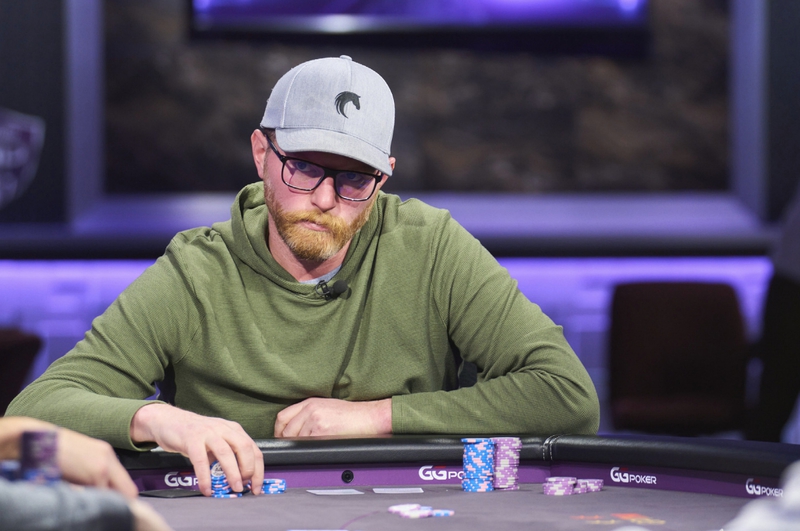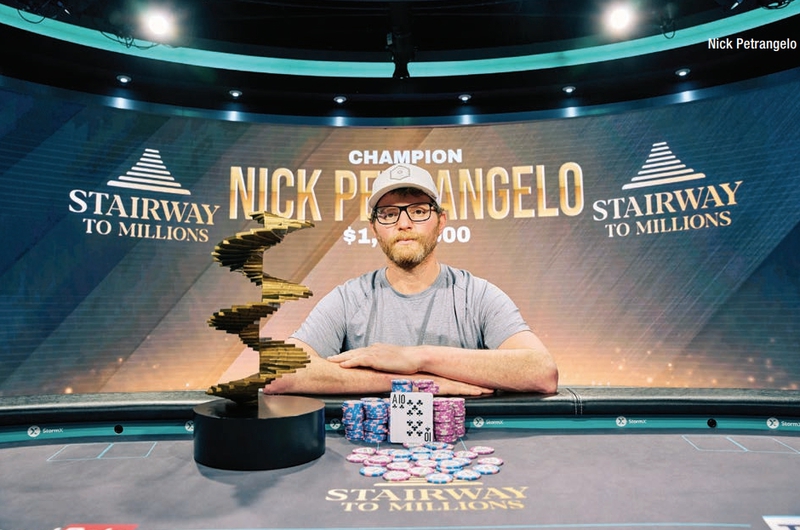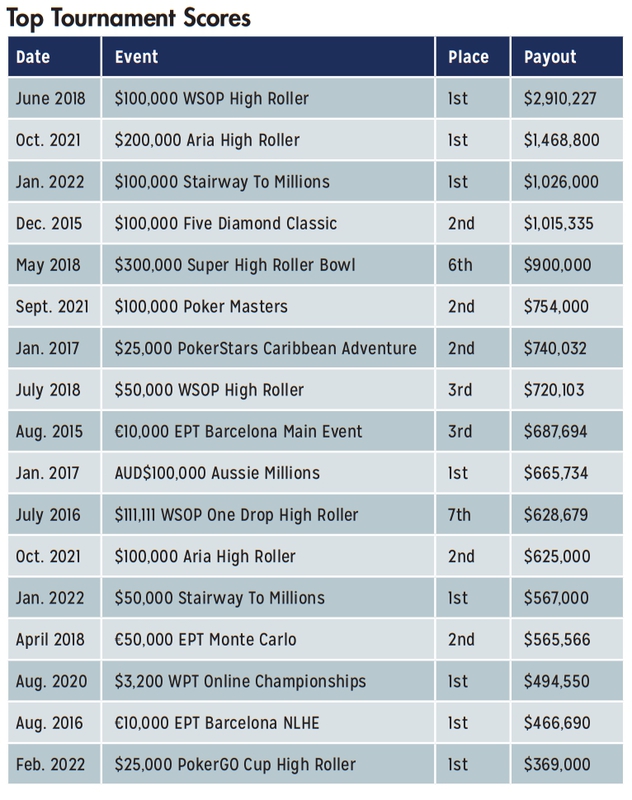






Nick Petrangelo Talks About The Pressure Of Playing High Rollers 'Under A Microscope'35-Year-Old High-Stakes Pro Takes His Turn On Top |
|
|
 This interview is featured in the March 23 issue of Card Player magazine.
This interview is featured in the March 23 issue of Card Player magazine.
Only two players have earned more cash on the tournament trail in the last six months than Nick Petrangelo.
The first is Australian Michael Addamo, who seemingly won every major high roller event in the last quarter of 2021. The second is German Koray Aldemir, who took down the World Series of Poker main event.
Petrangelo, a Massachusetts native who now resides in Las Vegas, has banked nearly $6 million since the end of last summer. That brings his lifetime live total to $24.2 million, which is good enough for no. 22 on poker’s all-time money list.
That feat is made even more incredible when you consider the fact that he didn’t even earn his first major score until 2015. He now sits in elite company just ahead of the likes of Phil Hellmuth, who is 57 years old and is considered one of the most decorated players in poker history.
The two-time WSOP bracelet winner made three final tables in September’s Poker Masters, and then followed that up with back-to-back scores in Aria super high rollers for a combined $2 million. Petrangelo finished the year with another high roller win at Bellagio Five Diamond World Poker Classic in December.
In January, Petrangelo took over the inaugural Stairway To Millions at the PokerGO studio in Las Vegas. It started with a runner-up finish in the $25,000 event for $175,000. The next day he won the $50,000 event for $567,000. He then late registered the $100,000 event, only to take it down for $1,026,000 and player of the series honors.
As a result, he now find himself sixth in the Card Player Player of the Year race, and in fourth place on the PokerGO Tour leaderboard, which only tracks events with a buy-in of $10,000 or more.
But despite his run, you won’t catch Petrangelo celebrating too much. The 35-year-old believes that his time on top is just a matter of variance, and frankly, was inevitable, especially given the hard work he puts in away from the poker table.
Card Player caught up with Petrangelo shortly after his $25,000 high roller win at the PokerGO Cup (he’s since added two more final tables at EPT Prague) to talk about his hot streak, keeping momentum, and the pressure that the top players put on each other to play perfectly.
Julio Rodriguez: Congratulations on all of your recent success! But before we get into that, I wanted to ask how your pandemic went, poker wise. There was a lot of high-stakes action online, but some players also took time off. What was your approach?
 Nick Petrangelo: I played a lot. There were really big cash games on GGPoker. So, I played a lot of that. I did really well in the cash games, but then I was break-even at tournaments with some really big swings. But the cash games made the tournament results pretty insignificant. We were playing $500-$1,000-$2,000.
Nick Petrangelo: I played a lot. There were really big cash games on GGPoker. So, I played a lot of that. I did really well in the cash games, but then I was break-even at tournaments with some really big swings. But the cash games made the tournament results pretty insignificant. We were playing $500-$1,000-$2,000.
JR: Any crazy big pots?
NP: I think the biggest pot I played was around $800,000. Big, but not crazy considering the stakes we were playing.
JR: That’s pretty close to what the record was when Ali Imsirovic broke it around that time. (Imsirovic won a pot worth $974,632 in August of 2020, breaking the previous no-limit hold’em online record. It has since been topped by Wiktor ‘Limitless’ Malinowski, who recently dragged a pot worth $1,447,347.)
NP: Yeah, that was the same game. We were both kind of in and out of that game whenever we could get a seat.
JR: Given all the attention that was showed to Imsirovic and Michael Addamo last year on the high roller circuit, did you feel like you were being ignored a bit?
NP: No. I mean, those guys are obviously great players, but there’s always going to be guys that are on crazy heaters. The media, fans, and even other players will want to attribute those results to some kind of above-the-rim strategy. But the truth is that there’s probably 10 to 20 guys that play, really, really well, and it’s going to be one of those guys at any given point.
 And when you’re one of those guys and you’re not on a heater, you just take every day one at a time and try and make the best decisions you can until your time comes. Variance will eventually even out, especially when you play as many of these as we do. That’s just how it is. Everyone wants to make a big story about heaters and winning, but the reality is that almost all of those guys are pretty much the same.
And when you’re one of those guys and you’re not on a heater, you just take every day one at a time and try and make the best decisions you can until your time comes. Variance will eventually even out, especially when you play as many of these as we do. That’s just how it is. Everyone wants to make a big story about heaters and winning, but the reality is that almost all of those guys are pretty much the same.
I’m more comfortable saying this now having gone through the heater myself. I don’t think I’m necessarily playing better than I was before. And I think when players pretend that’s not the case, it’s just annoying. Sorry, I know that’s not great content for the story. (laughing)
JR: I think it’s helpful for the readers to see the reality of the high roller world.
NP: During this stretch, I’m still doing the same process every day that I did before. I’m doing just as much work outside of actual playing as well. There are just these pivotal moments in each tournament, like a spot where you have a mandatory bluff that may or may not get through. The decision is correct, but what happens afterwards is not correlated at all, right?
Most of these guys that have been on these crazy runs, like Addamo and Ali, are geniuses. They are elite, make great adjustments, and are definitely some of the best players in the world. But there’s always going to be a guy who stands out in a certain time frame.
JR: What about momentum?
NP: That’s real. When you’re running well, it instills confidence. And confidence is important when you are trying to make the right decision in high-pressure, complicated situations. You are playing for massive pay jumps, and you’re on camera on a live stream.
If you’ve been winning all the money lately, then you have no problem pulling the trigger, even with an esoteric play that maybe only the top guys would understand. When you’re doing well and you’re in tune like that, you just feel like you know what the right decision is every time. Momentum is real, for sure.
JR: The top players spend much of their time away from the table studying solvers, but given these smaller player pools in the high rollers, do you ever study your individual opponents?
NP: I never miss a stream. Everything is streamed nowadays, even the online final tables. Between watching online and everything that happens in studio, that’s really important for understanding how the player pool behaves.

JR: You really watch most of the streams?
NP: No, I seriously watch all of the streams. I mean, most of the top guys do. The streams are on demand, so you don’t have to watch them live. I guess I would categorize it as passive studying… maybe text back and forth with another player who is watching it as well.
Then when I see some interesting happen, maybe a play I wouldn’t have made, I grab my laptop and check to see if he was on to something… if it was some kind of deviation [from a baseline strategy,] or even if it was just a mistake.
JR: I’m trying to picture LeBron James going back to his hotel room to randomly watch a Pistons-Pacers game and trying to care about it, you know? I’m honestly surprised that not only do you watch EVERY stream, but that you said most of the top players do.
NP: It’s a little different than a sport like basketball, because there are some behaviors that certain players approach in a binary way that you can glean a lot of information from. If they’re doing something wrong consistently and they don’t know about it, you can take advantage of that, even if it’s just for next week or even the next day.
JR: Does playing a $300,000 buy-in tournament feel any different than a $25,000? Do you get nervous anymore?

Moreso than the money, I think players feel more pressure from other players. It’s gotten so competitive that everyone is mostly concerned with making sure they make the ‘right’ decision every time in a given spot. In my opinion, the pressure that great players feel comes from the fact that you’re playing under a microscope with the live stream.
JR: Well yeah, especially knowing now that the top 20 players in the world are all watching and judging your every move.
NP: You can actually see it in the stream sometimes. Somebody might win a tournament and the only thing they can think about is a hand they might have f***ed up during four-handed play. It’s crazy, but it’s true. They’ll be texting everybody, trying to see if the play was good or bad. You’d think they’d be chill because they won the tournament, but they’re already worried about how that mistake could cost them down the line. That kind of pressure never really goes away.
JR: You’ve always been a sociable guy at the table, and in fact, a few years ago your fellow competitors voted you as the funniest player in our high roller survey. Is it me, or have the high rollers loosened up a bit in the last year? The players seem a little more laid back despite the stakes.
NP: There are certain guys in the player pool that no longer play that used to contribute to a slower pace. A real grind. Those guys haven’t been back yet, so that’s definitely a factor.
 But also, the group of guys that play now have always been pretty close with each other. Even if you don’t hang out outside of the poker room, they’re still friends at the studio or on a poker trip. It’s almost like they are co-workers. And then some of them are close friends, regardless of poker.
But also, the group of guys that play now have always been pretty close with each other. Even if you don’t hang out outside of the poker room, they’re still friends at the studio or on a poker trip. It’s almost like they are co-workers. And then some of them are close friends, regardless of poker.
The PokerGO studio has also contributed to the environment. It’s just so comfortable. We’re away from the casino, so it’s basically just like a giant home game.
I like to think of it like the players on the PGA Tour. Most of the time, they aren’t hitting a shot. They might be walking up the fairway to their ball or waiting on the group in front of them. They can’t just be completely dialed in 100 percent of the time. They get to make jokes with their caddy and the other guys.
Poker can be the same way. The super serious stare downs are done. That stuff’s over. Everyone realized it was bullshit.
JR: You’re now in the running for several POY awards, including our own Card Player Player of the Year race. Can I assume that’s not something you care about?
NP: It’s fun to look at, but no, it’s not something I worry about. I just don’t think I could ever put weight in an accolade that is basically just awarding a prize to the guy that ran the farthest above expectation. I’ve always thought that was pretty goofy. But then again, there are some guys, some really smart guys who are great players, who care a lot about that kind of stuff. Because that’s really all we have, right? Maybe I’m just grumpy.
 JR: Well then, what kind of goals do you set for yourself?
JR: Well then, what kind of goals do you set for yourself?
NP: I want to feel good about how I play. Luckily, it’s really easy to do that now with all of the ways you can check how you played. Also, every top player has their group that is willing to call you out for playing poorly. The less that happens, the better I feel I’m doing.
My goals aren’t volume based, and they definitely aren’t money based. They’re sort of process based. If I feel like I’m playing well and the other top guys are telling me I’m playing well, then that’s where I want to be.
*Some photos courtesy of PokerGO / Antonio Abrego.
